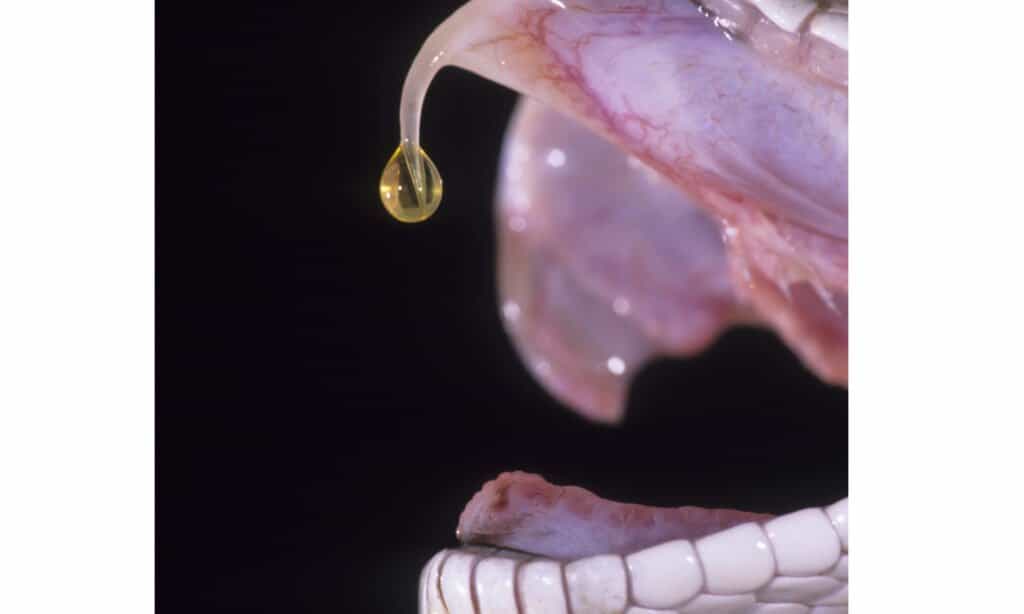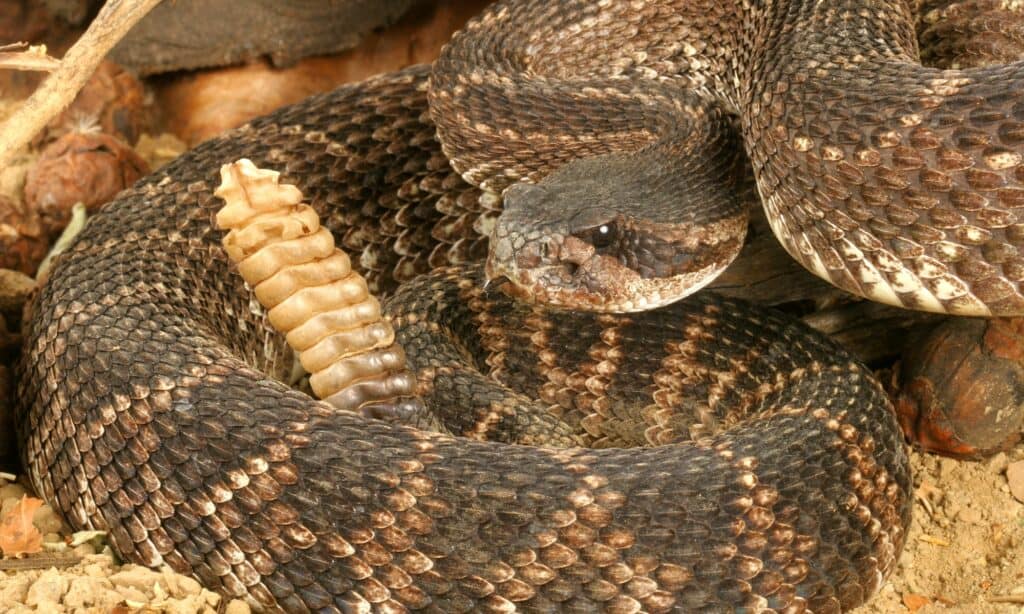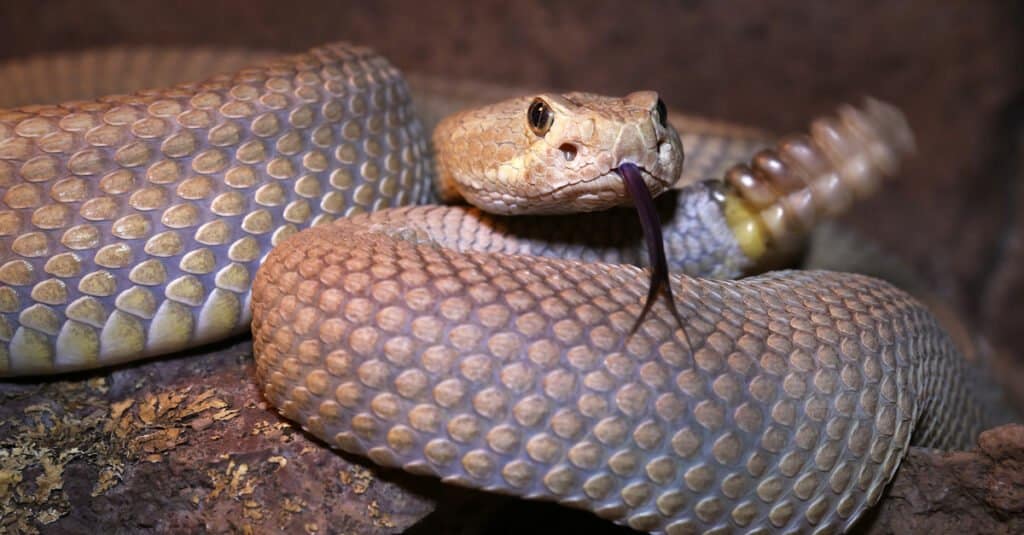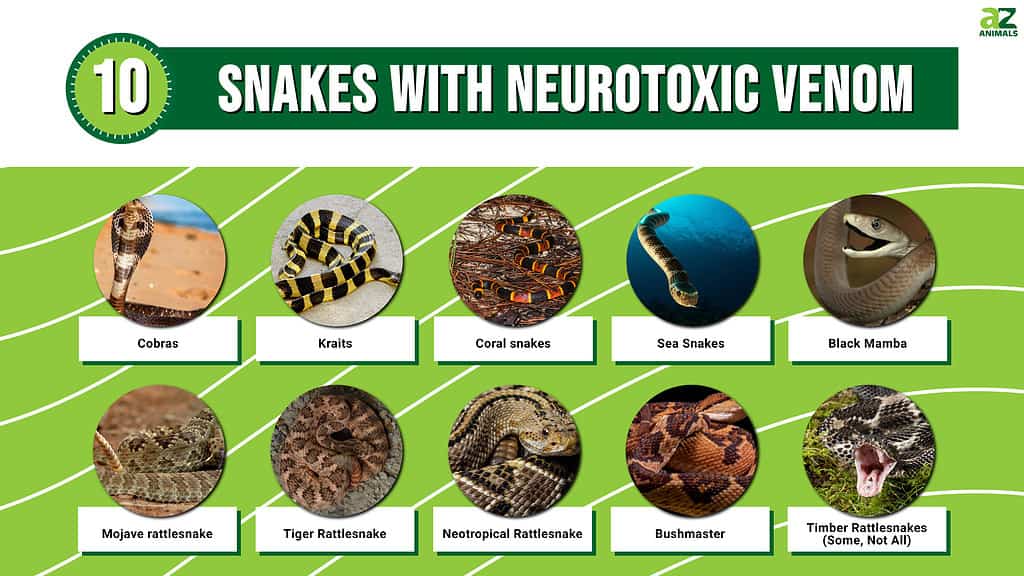Key Points:
- As proteolytic venom is found in all venomous snake venom, snakes can inject two or more types of snake venom at one time into their prey.
- Neurotoxic venom is the deadliest snake venom as it causes muscle paralysis, damage to the brain, loss of consciousness, and even death. Black mambas and coral snakes possess neurotoxic venom, so avoid these snakes!
- Other types of venom are hemotoxic (found in rattlesnakes, Russell’s viper, and copperheads) and cytotoxic (occurring in cobras and other elapids).
Snakes are limbless reptiles that are among the most feared animals on the planet. Although their form of locomotion may seem to limit them, they are among the deadliest animals alive. In fact, the Big Four snakes in the Indian subcontinent kill over 50,000 people per year and maim double that amount. The primary method that these deadly snakes use to harm people is their venom. We will examine the four types of snake venom and show you which of them you will want to avoid the most!

Why Do Some Snakes Use Venom?

Venom is a powerful tool that helps snakes kill prey many times their size.
©Joe McDonald/Shutterstock.com
Venomous snakes use venom to subdue their prey and aid with digestion. Numerous studies in the early 2000s showed that the venom used by elapid and viperid snakes would increase the release of free proteins and help break down cell structures.
Snake venom is a complex mixture of different organic compounds, so it’s fair to say that its uses may extend beyond killing prey. Also, some snakes have different venoms than others. While the aforementioned studies mentioned elapids and viperids, other types of venomous snakes exist.
Their venom may have evolved to kill specific populations, as is the case of the golden lancehead. This relative of the fer-de-lance has been effectively trapped on Snake Island, a small island located off the coast of Brazil. Since the island isn’t home to any mammal populations, their venom has since evolved to be more powerful on avian creatures.
What Are the 4 Types of Snake Venom?

Rattlesnakes primarily use a hemotoxic venom that destroys blood cells.
©iStock.com/johnaudrey
The four types of snake venom are proteolytic venom, hemotoxic venom, neurotoxic venom, and cytotoxic venom. However, proteolytic venom is often left off the list since it is present in all snake bites. We will take a closer look at each type and show you why these venoms are considered so deadly.
Proteolytic Venom
Proteolytic venom consists of proteolytic enzymes found in all venomous snakes that cause the degradation of tissue structures. Specifically, the venom acts at the site of the envenomation, and that’s part of the reason that humans see such dramatic changes where the bite occurs.
The venom breaks down blood vessel walls along with muscle tissue, accelerating the death of the prey and potentially helping with digestion. Large amounts of proteolytic venom are found in rattlesnakes and other pit vipers, working with their hemotoxic venom to inflict devastating wounds.
Hemotoxic Venom
Hemotoxic venom destroys the red blood cells in the body of an afflicted person while also impacting tissues and organs. People injected with hemotoxic venom will know right away in most cases. The venom breaks down cells and tissue around the injection site, leading to tremendous pain.
This venom can also cause blood clotting or even prevent blood clotting; either situation can be deadly. The results of this venom in humans include cardiovascular failure, loss of an affected limb, and massive internal bleeding.
Hemotoxic venom works slower than other types of snake venom, though. That means a person can often survive with proper medical attention.
Rattlesnakes, Russell’s viper, and copperheads are all snakes with hemotoxic venom.
Neurotoxic Venom
Snakes that inject neurotoxic venom impact animal’s nervous systems causing muscle paralysis, damage to the brain, and loss of consciousness. This sort of venom hinders the nerve impulses around parts of the body, acting very quickly in some cases.
Unlike hemotoxic venom, neurotoxic varieties can be delivered without a lot of pain. In fact, some people do not realize that they have been bitten until they begin feeling symptoms.
Black mamba venom can have noticeable symptoms in as few as 15 minutes and can render a human unconscious in less than an hour. Without treatment, which is hard to receive if one suddenly collapses, neurotoxic venom is often fatal.
Cytotoxic Venom
As the name suggests, cytotoxic venom kills cells. This type of venom is often found in cobras and other elapids. This venom is not as deadly as hemotoxic or neurotoxic venom. However, secondary injuries such as loss of limb function and other disabilities often stem from cytotoxic venom.
This venom is known to severely damage skin and underlying tissues, often leading to disabilities in the victim. Even if they survive the initial bite, these complications can leave the individual hindered for life.
Can Snakes Inject Multiple Types of Snake Venom?

Some mamba venom can contain multiple types of venom.
©Cormac Price/Shutterstock.com
Generally speaking, snakes can inject two or more types of snake venom into their foes. As mentioned before, proteolytic venom is found in all venomous snake venom. That means snakebites introduce at least two types of venom into a person.
Some snakes have a potent venom cocktail that has multiple sources of damage. For example, Jameson’s mamba has neurotoxins and hemotoxins present in its venom, allowing the snake to kill in as little as 30 minutes. The more complex the venom, the harder it is to mitigate all the damage it can do.
What Is the Worst of All Types of Snake Venom?

The Mojave
rattlesnake
is best known for its potent hemotoxic and neurotoxic venom.
©Ryan M. Bolton/Shutterstock.com
Of all the types of snake venom, neurotoxic venom is the deadliest snake venom and the one that most people will want to avoid. Depending on the amount of venom injected into a person and the victim’s health, this venom can kill in 30 minutes or a few hours.
Many neurotoxins are fatal without treatment. For example, the black mamba has a 100% fatality rate without treatment, making it the deadliest snake in the world. That doesn’t mean the other snake venoms are easy to deal with. Based on the immense pain that accompanies cytotoxic venom, most people will think that’s the worst one. Meanwhile, the necrosis that accompanies hemotoxic venom is enough to make people warier of that one. There is no good snake venom to be injected with.
Snake attacks are common in the world today. Modern medicine is helping the situation, but many people are still losing life and limb to these creatures. More research and increased cautiousness are required to save people in the future.
What Snakes Have Neurotoxic Venom?

If snakes with neurotoxic venom are the most deadly to humans, it stands to reason that we’d like to avoid them at all costs. Below are 10 types of snakes that have neurotoxic venom:
- Cobras–Types of cobras: King Cobra, Mozambique Spitting Cobra, Cape Cobra, Egyptian Cobra, Forest Cobra, Indian Cobra, and Philippian Cobra
- Kraits–Types of Kraits: Indian (Common) Krait, Banded Krait, Many-Banded Krait, Banded Sea Krait, and Malayan Krait
- Coral Snakes–Types of coral snakes: Eastern, Western, Central American, Texas, Caatinga, Mayan, Redtail, Painted, Southern, Argentinian, Aquatic, and South American
- Sea Snakes–Types of sea snakes: Beaked Sea Snake, Yellow-Bellied, Spiny-Headed, Northern Mangrove
- Black Mambas–Types of black mambas: Black Mamba, Western Green Mamba, Jameson’s Mamba, Eastern Green Mamba
- Mojave Rattlesnake
- Tiger Rattlesnake
- Neotropical Rattlesnake
- Bushmaster
- Timber Rattlesnake (some varieties in the Southeastern U.S.)
Summary of the 4 Types of Snake Venom and the One You Want to Avoid Most
Here’s a recap of the different types of snake venom and the damage they can cause.
| # | Venom | Damage It Inflicts | What Snake Is It Found In |
|---|---|---|---|
| 1 | Proteolytic | Breaks down blood vessel walls along with muscle tissue, accelerating the death of the prey | Found in all venomous snakes |
| 2 | Hemotoxic | Destroys the red blood cells; can also cause blood clotting or even prevent blood clotting, cardiovascular failure, loss of affected limb, and massive internal bleeding. | Rattlesnakes, Russell’s viper, and copperheads |
| 3 | Neurotoxic *Worst Venom — you want to avoid this the most* | Causes muscle paralysis, damage to the brain, and loss of consciousness, even death. | Black Mambas, Coral snakes |
| 4 | Cytotoxic | Kills cells, severely damaging skin and underlying tissues | Cobras and other elapids |
The photo featured at the top of this post is © Eugene Troskie/Shutterstock.com
Discover the "Monster" Snake 5X Bigger than an Anaconda
Every day A-Z Animals sends out some of the most incredible facts in the world from our free newsletter. Want to discover the 10 most beautiful snakes in the world, a "snake island" where you're never more than 3 feet from danger, or a "monster" snake 5X larger than an anaconda? Then sign up right now and you'll start receiving our daily newsletter absolutely free.
Thank you for reading! Have some feedback for us? Contact the AZ Animals editorial team.






